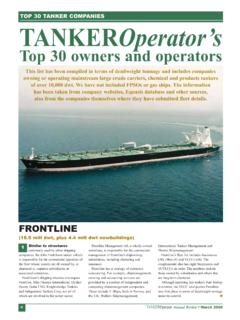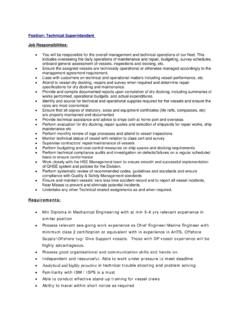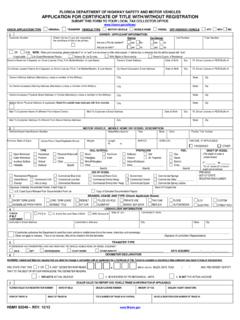Transcription of CO2 Emission Statistics for the World Commercial Fleet
1 WMU Journal of Maritime Affairs, (2009) World Maritime University. All rights reserved. ISSN: 1651-436X print/1654-1642 online CO2 Emission Statistics for the World Commercial Fleet * Harilaos N. Psaraftis and Christos A. Kontovas * To appear in WMU Journal of Maritime Affairs, 2009. Professor, Laboratory for Maritime Transport, School of Naval Architecture and Marine Engineering, National Technical University of Athens, Iroon Polytechniou 9, Zografou 15773, Greece, email: Laboratory for Maritime Transport, National Technical University of Athens, Greece Abstract The purpose of this paper is to present an analysis of carbon dioxide (CO2) emissions of the World Commercial Fleet . The analysis is based on the Lloyds-Fairplay World ship database for 2007 and produces various emissions Statistics of the following major ship types: bulk carriers, crude oil tankers, container vessels, product/chemical carriers, LNG carriers, LPG carriers, reefer vessels, Ro-Ro vessels and general cargo ships.
2 A separate analysis is carried out for small vessels under 400 GRT and for passenger vessels. The main outputs from this analysis for each ship type-size bracket are the emitted grams of CO2 per tonne-km and an estimate of the total CO2 produced in a year. The methodology for estimating these Statistics is described, and a comparison with other studies is made. Key words: Ship CO2 emissions , Ship air pollution, Modelling of ship fuel consumption and emissions , Greenhouse gases and shipping. 1 Introduction Carbon dioxide (CO2) emissions from Commercial shipping are currently unregulated. Nevertheless, they are a subject of intense scrutiny by the World shipping community. According to the Kyoto protocol to the United Nations Framework Convention on Climate Change -UNFCCC (1997), definite measures to reduce CO2 emissions are necessary in order to curb the projected growth of greenhouse gases (GHG) worldwide.
3 Shipping has thus far escaped being included in the Kyoto global emissions reduction target for CO2 and other GHG, but it is clear that the time of non-regulation is rapidly approaching its end, and measures to curb future CO2 growth are being sought with a high sense of urgency. CO2 is the most prevalent of these GHGs, and it is therefore clear that any set of measures to reduce the latter should primarily focus on In parallel, the broader analysis of other greenhouse gases (such as CH4 and N2O) and other, non-greenhouse gases, such as SO2, NOx and others is already very high on the International Maritime Organization s (IMO) agenda. Various analyses of many aspects of the problem have been and are being carried out and a spectrum of measures are being contemplated. It is clear that a reliable emissions inventory is essential for both scientists and policy-makers in order to formulate and evaluate the implementation of relevant regulations.
4 To contribute to this debate and possibly complement other studies on the subject, the authors of this paper have conducted their own analysis on emissions of the World Fleet database (as provided by Lloyds Fairplay for year 2007) and can herein present some preliminary results of the emissions Statistics of the following major ship types: bulk carriers, crude oil tankers, container vessels, product/chemical carriers, LNG carriers, LPG carriers, reefer vessels, Ro-Ro vessels and general cargo ships. A separate analysis was carried out for small vessels under 400 GRT and for passenger Psaraftis and Kontovas 2 vessels. The study was conducted by the National Technical University of Athens (Laboratory for Maritime Transport) for the Hellenic Chamber of Shipping (HCS). The study had the following original objectives: (a) develop a web-based tool for calculating the exhaust gas emissions (CO2, SO2 and NOx) of specific types of ships under a variety of operational scenarios, and (b) produce various Statistics of CO2 emissions , based on data from the World Fleet database.
5 Reporting on objective (a) is outside the scope of this paper and is done elsewhere. The reader is referred to the study s public final report for more details (see Psaraftis and Kontovas, 2008). The emissions web tool is freely available on-line1 and is the analogue of what some airlines have available on their web sites (tools available on-line) and of what some container lines have available for their customers (tools not available on-line). One main output statistic of the World Fleet analysis of this paper is the ratio of emitted grams of CO2 per tonne-km of transported cargo. The authors of this paper consider this statistic (which has been used for other transport modes as well) as reasonably representative of a vessel s environmental performance in an operational setting. Another emissions statistic is an estimate of total CO2 emitted (in million tonnes per year) per size bracket for the above ship types (as compared to billions of tonne-kilometers carried by the same size bracket).
6 Such Statistics have been estimated for a variety of ship types and sizes and under a variety of scenarios as regards sea-to-port time, ship speed and fuel consumption at sea and in port. Some sensitivity analysis of these results has also been conducted. The description of the methodology and the results of this analysis are included in the rest of this paper. The rest of this paper is organized as follows. Section 2 reports on relevant literature. Section 3 describes the methodology used in the paper. Section 4 describes the runs performed on the World shipping database. Section 5 comments on comparison with other studies and other modes. Finally Section 6 presents the paper s conclusions. 2 Relevant Literature Looking at the literature on the broad area of this paper (including both scientific work and regulation-related documents), it is no surprise that the relevant material is immense.
7 MEPC 572 alone had some 65 submissions, MEPC 58 had 45 submissions and the GHG intersessional group meeting in Oslo, Norway in June of 2008 had some 20 submissions. Still, we collected and studied a large number of such documents by focusing (a) on relations linking parameters such as bunker consumption, engine type and horsepower, to produced emissions of various exhaust types, (b) on data that can be used as inputs for our study (for instance, bunker consumption for various ship types) and (c) on various other reported Statistics (for instance, bunker consumption). The latest documents that were reviewed before the study was completed were related to recent submissions to MEPC 57 and to BLG 123. After the study was completed, and as the final version of this paper was being written, we also reviewed documents that were submitted to MEPC 58 and, especially, the report of Phase 1 on the updated IMO study on GHG emissions from ships, of which more is discussed in section of the paper (Buhaug et al, 2008).
8 Among the number of related IMO documents, perhaps the most seminal one from 2000 to mid-2008 was IMO (2000), in which an international consortium led by Marintek (Norway) delivered a report on GHG emissions from ships which included an estimation of the 1996 emissions inventory and the 1 Please go to . 2 MEPC: IMO s Marine Environment Protection Committee. MEPC 57 was the committee s 57th session, held in London on March 31- April 4, 2008. MEPC 58 was the committee s 58th session, held also in London on October 6- October 10, 2008 3 BLG: IMO s Subcommittee on Bulk Liquids and Gases. BLG 12 is the subcommittee s 12th session, held in London, on February 4-8, 2008. CO2 Emission Statistics for the World Commercial Fleet 3examination of Emission reduction possibilities through technical, operational and market-based approaches. The Secretary-General of the IMO at MEPC 56 (London, July 2007) proposed the setting up of an informal Cross Government/Industry Scientific Group of Experts to evaluate the effects of the different fuel options proposed under the revision of MARPOL Annex VI and the NOx Technical Code.
9 IMO(2007a) presented the inputs from the four subgroups to the final report. Among others, there is a section which contains the estimations of the fuel consumption and emissions for 2007 as well as the predicted trends leading to 2020. IMO(2007b) was the report on the outcome of this group of experts. Subsequently, MEPC 58 unanimously adopted amendments to the MARPOL Annex VI regulations. The main changes will see a progressive reduction in sulphur oxide (SOx) emissions from ships, with the global sulphur cap reduced initially to , effective 1 January 2012; then progressively to %, effective 1 January 2020 (IMO, 2008b). Outside IMO documents, detailed methodologies for constructing fuel-based inventories of ship emissions have been published by Corbett and K hler (2003), Endresen et al (2003, 2007), Eyring et al (2005), and in EMEP/CORINAIR (2002). The third edition of the Atmospheric Emission Inventory Guidebook was released by the EMEP Task Force on Emission Inventories.
10 The guidebook outlined two methodologies (simple and detailed) for reporting national marine emissions for EU member states. The Emission factors that were recommended in EMEP/CORINAIR in their 1999 study are widely used in the estimation of Emission inventories (see, for example, IMO(2000), EMEP/CORINAIR(2002) and Endresen(2007)). Corbett and K hler (2003) estimate global fuel consumption for ships greater than 100 GRT by using engine power and vessel activity data. Endresen at al (2003) did a similar work but improved the spatial representation of global ship air emissions by weighting ship reporting frequencies using the Automated Mutual-assistance Vessel Rescue system (AMVER) data set. The estimates of fuel consumption and emissions derived by Endresen et al. (2003) were significantly lower than those in Corbett and K hler (2003) and Eyring et al. (2005).







